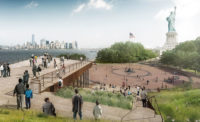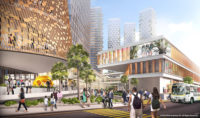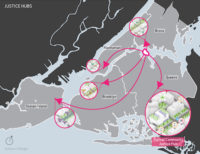From the top of Outlook Hill on Governors Island, the 172-acre land mass in New York Harbor, views of the city unfurl in a postcard-worthy panorama: the eye glides from the glossy skyscrapers of Lower Manhattan to the mint-green silhouette of Lady Liberty, across the channel to Brooklyn and the borough’s iconic bridge.
Two years ago, this vista didn’t exist. The peak, along with three others, was grafted onto the landscape as part of a multi-phased master plan by the international landscape firm West 8 and constitutes a new area on the island called “the Hills.” On July 19, nearly a decade after the firm won a competition to reimagine the southern portion of Governors Island, the Hills will open to the public.
Led by Dutch landscape architect Adriaan Geuze, West 8 has created an elaborate game of hide-and-seek with the topography. Meandering paths wind through the Hills’ sloping peaks and valleys and curve around expansive lawns, offering visitors fleeting vistas of the surrounding cityscape and bay. “All the time you are walking, you have a different view,” says Geuze. “You are hardly aware how rich the landscape is but are fully engaged with the harbor.”
Governors Island, though just 800 yards from Manhattan, was off-limits to the public for much of its four-century history, used for defensive purposes beginning with early Dutch settlers. Most recently, the U.S. Coast Guard had a base there until it closed in 1996, leaving behind a small city. When West 8 began work on the master plan in 2007, the island had only been accessible to the public for two years.
During the first phase of the plan, West 8 elevated the land 15 feet above existing grade, based on changing-sea-level estimates. After these resiliency measures, the landscape architects developed the parkland’s first 30 acres, which included a landscaped plaza called Liggett Terrace adjacent to a McKim Mead & White structure, a grove dotted with mobile furniture and hammocks, and a lawn with two ball fields.
Asphalt bicycle paths were made to meander south toward the Hills created as part of the master plan’s second phase. The paths are edged by bright-white concrete curbs stamped in squiggly organic patterns and built up at intervals to form seating.
The four hills—Outlook, Grassy, Slide, and Discovery Hill—are made from nearly 300,000 cubic yards of fill. (West 8 worked closely with geotechnical engineers so that the man-made portions of the island wouldn’t sink.) The steepest slopes were formed in layers, “like lasagna,” says Geuze. Debris from demolished Coast Guard residences underpins the hills (Outlook Hill, the tallest at 70 feet, also includes lightweight pumice stone). This layer was topped with 3 feet of topsoil and, at the steepest parts, secured by metal mesh. Finally, the landforms were seeded and planted. On the newly landscaped slopes, 860 saplings shudder in the strong salty wind.
Mica-flecked granite blocks—remnants of the Island’s old seawall—form a rough “scramble” to the summit of Outlook Hill. Geuze scales the slope and pauses at the top. “People will navigate here to take pictures,” he says, snapping a photo of the harbor with his iPhone.
While this area offers amazing views, there are other surprises to be found here. On the south side of the 39-foot-tall Discovery Hill is Cabin, a ghostly installation by British artist Rachel Whiteread. On another hill, four steep slides are embedded in the slope. “The design is meant to trigger playfulness and lightness,” explains Geuze. “It’s ambiguous—are these for children or for all of us?”
Even more transformations are in store for Governors Island. In his state of the city address this February, New York Mayor Bill de Blasio announced plans for a new “Innovation Cluster” on the island to generate new businesses and job opportunities. “Governors Island is a treasure for the whole city, and it’s ready for its next great chapter,” the mayor said.
That new chapter has already begun: near Liggett Terrace, a girl on a bicycle zips down the white-piped paths, a redwing blackbird perches in a swaying tree surrounded by grasses, and schoolchildren in neon-green T-shirts file toward the ferry back to Manhattan.
“Your mindset changes when you are on the island,” says Geuze. “People from every background meet on the ferry boat; you feel like you are on a journey together."


















Post a comment to this article
Report Abusive Comment